同济大学:《固体废物处理与资源化》课程教学资源(讲稿)Waste processing technologies application
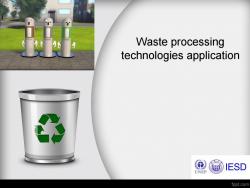
Waste processing technologies application 9 IESD UNEP fppt.com
Waste processing technologies application
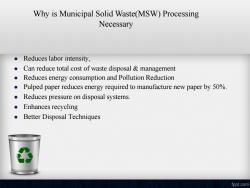
Why is Municipal Solid Waste(MSW)Processing Necessary Reduces labor intensity, Can reduce total cost of waste disposal management Reduces energy consumption and Pollution Reduction Pulped paper reduces energy required to manufacture new paper by 50%. Reduces pressure on disposal systems. ● Enhances recycling Better Disposal Techniques fppt.com
Reduces labor intensity, Can reduce total cost of waste disposal & management Reduces energy consumption and Pollution Reduction Pulped paper reduces energy required to manufacture new paper by 50%. Reduces pressure on disposal systems. Enhances recycling Better Disposal Techniques Why is Municipal Solid Waste(MSW) Processing Necessary
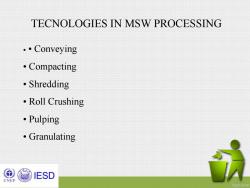
TECNOLOGIES IN MSW PROCESSING .·Conveying Compacting ·Shredding ·Roll Crushing ·Pulping ·Granulating IESD UNEP fppt.com
• • Conveying • Compacting • Shredding • Roll Crushing • Pulping • Granulating TECNOLOGIES IN MSW PROCESSING
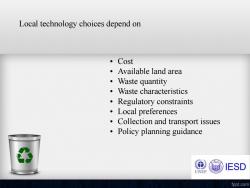
Local technology choices depend on Cost ·Available land area ·Waste quantity Waste characteristics Regulatory constraints ·Local preferences Collection and transport issues Policy planning guidance 红 IESD UNEP fppt.com
Local technology choices depend on • Cost • Available land area • Waste quantity • Waste characteristics • Regulatory constraints • Local preferences • Collection and transport issues • Policy planning guidance
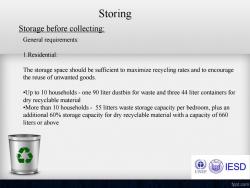
Storing Storage before collecting: General requirements: 1.Residential: The storage space should be sufficient to maximize recycling rates and to encourage the reuse of unwanted goods. .Up to 10 households-one 90 liter dustbin for waste and three 44 liter containers for dry recyclable material .More than 10 households-55 litters waste storage capacity per bedroom,plus an additional 60%storage capacity for dry recyclable material with a capacity of 660 liters or above 》 IESD UNEP fppt.com
Storing Storage before collecting: General requirements: 1.Residential: The storage space should be sufficient to maximize recycling rates and to encourage the reuse of unwanted goods. •Up to 10 households - one 90 liter dustbin for waste and three 44 liter containers for dry recyclable material •More than 10 households - 55 litters waste storage capacity per bedroom, plus an additional 60% storage capacity for dry recyclable material with a capacity of 660 liters or above
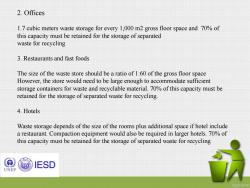
2.Offices 1.7 cubic meters waste storage for every 1,000 m2 gross floor space and 70%of this capacity must be retained for the storage of separated waste for recycling 3.Restaurants and fast foods The size of the waste store should be a ratio of 1:60 of the gross floor space However,the store would need to be large enough to accommodate sufficient storage containers for waste and recyclable material.70%of this capacity must be retained for the storage of separated waste for recycling 4.Hotels Waste storage depends of the size of the rooms plus additional space if hotel include a restaurant.Compaction equipment would also be required in larger hotels.70%of this capacity must be retained for the storage of separated waste for recycling IESD UNEP fppt.com
2. Offices 1.7 cubic meters waste storage for every 1,000 m2 gross floor space and 70% of this capacity must be retained for the storage of separated waste for recycling 3. Restaurants and fast foods The size of the waste store should be a ratio of 1:60 of the gross floor space However, the store would need to be large enough to accommodate sufficient storage containers for waste and recyclable material. 70% of this capacity must be retained for the storage of separated waste for recycling. 4. Hotels Waste storage depends of the size of the rooms plus additional space if hotel include a restaurant. Compaction equipment would also be required in larger hotels. 70% of this capacity must be retained for the storage of separated waste for recycling
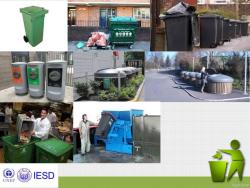
9苹是 IESD UNEP fppt.com
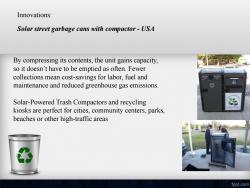
Innovations: Solar street garbage cans with compactor-USA By compressing its contents,the unit gains capacity, so it doesn't have to be emptied as often.Fewer collections mean cost-savings for labor,fuel and maintenance and reduced greenhouse gas emissions. Solar-Powered Trash Compactors and recycling kiosks are perfect for cities,community centers,parks, beaches or other high-traffic areas fppt.com
Innovations: Solar street garbage cans with compactor - USA By compressing its contents, the unit gains capacity, so it doesn’t have to be emptied as often. Fewer collections mean cost-savings for labor, fuel and maintenance and reduced greenhouse gas emissions. Solar-Powered Trash Compactors and recycling kiosks are perfect for cities, community centers, parks, beaches or other high-traffic areas
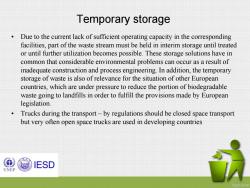
Temporary storage Due to the current lack of sufficient operating capacity in the corresponding facilities,part of the waste stream must be held in interim storage until treated or until further utilization becomes possible.These storage solutions have in common that considerable environmental problems can occur as a result of inadequate construction and process engineering.In addition,the temporary storage of waste is also of relevance for the situation of other European countries,which are under pressure to reduce the portion of biodegradable waste going to landfills in order to fulfill the provisions made by European legislation. Trucks during the transport-by regulations should be closed space transport but very often open space trucks are used in developing countries 价 IESD UNEP fppt.com
Temporary storage • Due to the current lack of sufficient operating capacity in the corresponding facilities, part of the waste stream must be held in interim storage until treated or until further utilization becomes possible. These storage solutions have in common that considerable environmental problems can occur as a result of inadequate construction and process engineering. In addition, the temporary storage of waste is also of relevance for the situation of other European countries, which are under pressure to reduce the portion of biodegradable waste going to landfills in order to fulfill the provisions made by European legislation. • Trucks during the transport – by regulations should be closed space transport but very often open space trucks are used in developing countries
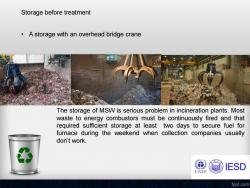
Storage before treatment A storage with an overhead bridge crane The storage of MSW is serious problem in incineration plants.Most waste to energy combustors must be continuously fired and that required sufficient storage at least two days to secure fuel for furnace during the weekend when collection companies usually don't work. IESD UNEP fppt.com
Storage before treatment • A storage with an overhead bridge crane The storage of MSW is serious problem in incineration plants. Most waste to energy combustors must be continuously fired and that required sufficient storage at least two days to secure fuel for furnace during the weekend when collection companies usually don’t work
按次数下载不扣除下载券;
注册用户24小时内重复下载只扣除一次;
顺序:VIP每日次数-->可用次数-->下载券;
- 同济大学:《固体废物处理与资源化》课程教学资源(讲稿)Introduction on Solid Waste.pdf
- 《固体废物处理与资源化》课程教学资源(文献资料)LANDFILL MANUALS LANDFILL SITE DESIGN.pdf
- 《固体废物处理与资源化》课程教学资源(文献资料)The anaerobic digestion process of biogas production from food waste - Prospects and constraints.pdf
- 《固体废物处理与资源化》课程教学资源(文献资料)Efficient reduction of antibiotic residues and associated resistance genes in tylosin antibiotic fermentation waste using hyperthermophilic composting.pdf
- 《固体废物处理与资源化》课程教学资源(文献资料)A feasibility assessment of an integrated plastic waste system adopting.pdf
- 长沙理工大学:《环境监测》课程教学资源(课件讲稿,打印版)第9章 环境监测质量保证.pdf
- 长沙理工大学:《环境监测》课程教学资源(课件讲稿,打印版)第5章 土壤质量监测 Soil Pollution Monitoring.pdf
- 长沙理工大学:《环境监测》课程教学资源(课件讲稿,打印版)第3章 大气和废气监测 Atmosphere and flue waste gas monitoring.pdf
- 长沙理工大学:《环境监测》课程教学资源(课件讲稿,打印版)第2章 水和废水监测.pdf
- 长沙理工大学:《环境监测》课程教学资源(实验指导,打印版)实验8 生化需氧量的测定.pdf
- 长沙理工大学:《环境监测》课程教学资源(实验指导,打印版)实验7 化学需氧量的测定.pdf
- 长沙理工大学:《环境监测》课程教学资源(实验指导,打印版)实验5 碘量法测定水中溶解氧.pdf
- 长沙理工大学:《环境监测》课程教学资源(实验指导,打印版)实验6 水中铬的测定.pdf
- 长沙理工大学:《环境监测》课程教学资源(实验指导,打印版)实验4 水中氟化物的测定(离子选择电极法).pdf
- 长沙理工大学:《环境监测》课程教学资源(实验指导,打印版)实验3 氨氮的测定.pdf
- 长沙理工大学:《环境监测》课程教学资源(实验指导,打印版)实验2 颜色的测定.pdf
- 长沙理工大学:《环境监测》课程教学资源(实验指导,打印版)实验1 废水悬浮固体和浊度的测定.pdf
- 《环境监测》课程教学资源(作业习题)问答题(打印版,含答案).pdf
- 《环境监测》课程教学资源(作业习题)判断题(打印版,含答案).pdf
- 《环境监测》课程教学资源(作业习题)选择题(打印版,含答案).pdf
- 同济大学:《固体废物处理与资源化》课程教学资源(讲稿)Biogas – a way to solve sanitation problems.pdf
- 同济大学:《固体废物处理与资源化》课程教学资源(讲稿)Incineration, pyrolysis & gasification.pdf
- 同济大学:《固体废物处理与资源化》课程教学资源(讲稿)Leachate and Landfill Gas.pdf
- 同济大学:《给水工程原理与技术》课程电子教案(课件讲稿)Sedimentation.pdf
- 同济大学:《给水工程原理与技术》课程电子教案(课件讲稿)Filtration.pdf
- 同济大学:《给水工程原理与技术》课程电子教案(课件讲稿)Membrane technology.pdf
- 同济大学:《给水工程原理与技术》课程电子教案(课件讲稿)Municipal Water Purification Plant.pdf
- 同济大学:《给水工程原理与技术》课程电子教案(课件讲稿)Advanced Oxidation.pdf
- 同济大学:《给水工程原理与技术》课程电子教案(课件讲稿)Mixing Coagulation - Flocculation.pdf
- 同济大学:《水资源管理》课程教学资源(教案讲义)01 Introduction to water resources(负责人:王洪涛).pdf
- 同济大学:《水资源管理》课程教学资源(教案讲义)02 Water Resources Management Tool - Water Footprint(WF).pdf
- 同济大学:《水资源管理》课程教学资源(教案讲义)03 Energy-water nexus in urban water systems.pdf
- 同济大学:《水资源管理》课程教学资源(教案讲义)04 Water Quality Modeling、Reactions & Transport、Dissolved Oxygen Modeling in Rivers、Eutrophication.pdf
- 同济大学:《水资源管理》课程教学资源(教案讲义)05 Trans-boundary water resources management.pdf
- 同济大学:《水资源管理》课程教学资源(教案讲义)06 Water Resource Management - Sponge City.pdf
- 同济大学:《水资源管理》课程教学资源(教案讲义)08 Case in Lake Victoria, East Africa.pdf
- 同济大学:《水资源管理》课程教学资源(教案讲义)07 Brief Introduction to Integrated Water Environment Rehabilitation、A Big Picture:China City’s Effort to Improve River Water Quality with Shanghai as a Case、River water quality assessment and water pollution sources survey.pdf
- 上海海洋大学:海洋生态与环境学院课程教学大纲汇编(2018版).pdf
- 兰州交通大学:《环境保护与可持续发展》课程教学资源(大纲讲义)教学大纲 Environmental protection and sustainable development.pdf
- 兰州交通大学:《环境保护与可持续发展》课程教学资源(试卷习题)试卷1.doc
